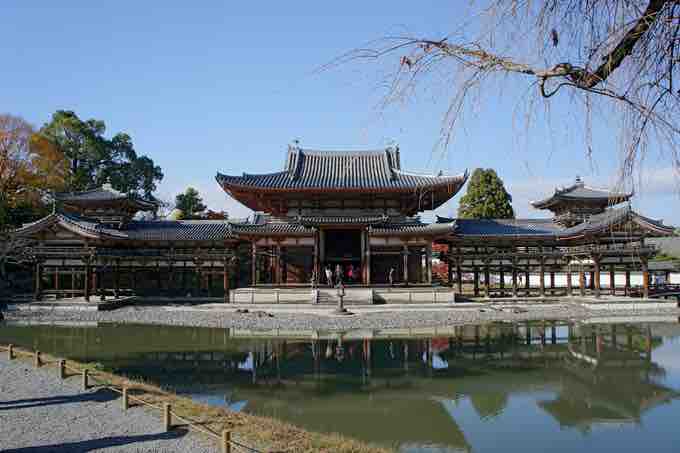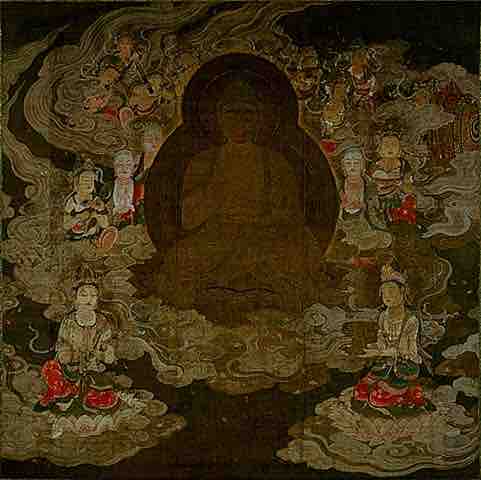Background: The Heian Period
In 784, the Japanese Emperor Kammu, threatened by the growing secular power of the Buddhist institutions in the city of Nara, moved the capital of Japan to Heian-kyō (Kyōto), which remained the imperial capital for the next 1,000 years. The Heian Period, as it came to be called, refers to the years between 794 and 1185, when the Kamakura shogunate was established at the end of the Genpei War. It is considered Japan's "Golden Age," a high point in Japanese culture that later generations have always admired. The period is also noted for the rise of the samurai class, which would eventually take power and start the feudal period of Japan.
Influence of Esoteric Buddhism
The Late Nara period saw the introduction of Esoteric Buddhism to Japan from China by Kūkai and Saichō, who founded the Shingon and Tendai schools. The Heian period witnessed a flowering of Buddhist art and architecture and the introduction of Esoteric Buddhism to Japan. Early Heian period sculptures inherited and modified late Nara period sculptural forms while developing new images to depict wrathful Esoteric deities. During this time, wood also replaced bronze as the most common material for making Buddhist sculptures.
Kūkai impressed the emperors who succeeded Emperor Kammu, and also generations of Japanese, not only with his religious practices but also with his poetry, calligraphy, painting, and sculpture. Shingon Buddhist practice is based on various rituals, including the chanting of mantras, hand gestures (mudras), and meditation through visualization of mandalas. The central role of these ritual in Japanese Esoteric Buddhism led to a flourishing of the religious arts in the Heian period. Religious paintings, mandalas, and statues provided practitioners with ways to contemplate Buddhist deities and concepts.
A famous example of a Shingon mandala is the Taizokai (Womb World) mandala. Part of the Mandala of the Two Realms, the Womb World is composed of 12 zones representing different dimensions of Buddha nature. In the center sits the Vairocana Buddha within the lotus of compassion, surrounded by attendant Buddhas and Bodhisattvas. The Shingon sect believed that all beings have an innate Buddha nature.
Taizokai (Womb World) mandala (Second Half of the Ninth Century)
The center square represents the young stage of Vairocana Buddha. (hanging scroll, color on silk)
Pure Land Buddhism and the Fujiwara Regency
Pure Land Buddhism is a branch of Buddhism that offers salvation through belief in Amida Buddha (the Buddha of the Western Paradise). This branch of Buddhism became popular in Japan during the Fujiwara regency (794–1185), named for the powerful clan that dominated Japanese politics in the middle Heian period. The Fujiwara family, then the most powerful in the country, ruled as regents for the Emperor, effectively becoming hereditary civil dictators. Formal trade with China ended, allowing for the development of indigenous cultural forms. The Fujiwara period was a time of cultural and artistic flowering at the imperial court and among the aristocracy, and the Kyoto nobility developed a society devoted to elegant aesthetic pursuits.
The Amida Hall
New types of images were developed to satisfy the devotional needs of the increasingly important Pure Land sects in the 10th century. They created a new form of Buddha hall, known as the Amida hall. This new hall blends the secular with the religious and houses one or more Buddha images within a structure resembling the mansions of the nobility. The Hō-ō-dō (Phoenix Hall, completed in 1053) of the Byōdō-in, a temple in Uji to the southeast of Kyoto, is one of the finest examples of Fujiwara Amida halls. It consists of a main rectangular structure flanked by two L-shaped wing corridors and a tail corridor, set at the edge of a large artificial pond. Inside, a single golden image of Amida (c. 1053) is installed on a high platform.

Byōdō-in Phoenix Hall, Uji, Kyoto
The Phoenix Hall of the Byōdō-in is an exampla of Fujiwara Amida halls.
Raigō
Other popular images used include the Raigō, which depicts the appearance of the Amida Buddha on a floating cloud along with his attendant celestial Bodhisattvas, Kannon and Seishi, at the time of one's death. A fine example of this type of image is found in the Phoenix Hall, whose walls are decorated with small relief carvings. These carvings depict the host who is believed to have accompanied Amida when he descended from his celestial realm to gather the souls of believers at the moment of death and transport them in lotus blossoms to the Western Paradise.
A famous early example of Raigō imagery dating from 1053 CE is painted on the interior of the Phoenix Hall doors of the Hō-ō-dō. It depicts the descent of the Amida Buddha and is one of the first examples of Yamato-e, a classical style of Japanese painting inspired by Tang dynasty paintings and fully developed by the late Heian period. It contains landscape elements such as soft rolling hills that seem to reflect the actual appearance of the scenery around Kyoto. Stylistically, the painting is deeply influenced by the Tang Dynasty Chinese "blue and green style" of landscape painting traditions.

Amida Raigo painting
Color on silk, late Heian period. The Raigo image was introduced in Japan by the Pure Land School of Art during the Fujiwara Regency.
Amida Sculpture
A growing sense of grace, refinement, and softness emerged in Amida-style Buddhist sculptures, which culminated in the work of Jōchō (d. 1057), a Japanese sculptor of the Heian period. Jōchō's workshop in Kyoto perfected the Wayō or "Japanese style" of sculpture. He used a new canon of proportions along with a new technique, yosegi, in which a single image is carved from multiple pieces of wood that are joined from the inside. While this technique limited the amount of surface detail an artist could carve into each piece, the method forced the sculptor to convey his intended message within these preset limits. This resulted in finer and more ephemeral looking pieces. Most importantly, it allowed several assistants to work on the sculpture at once, thus greatly speeding up the process. Jōchō's sculptures were remarkable for their intricately carved halos and the kindness and compassion of their elegant facial expressions.